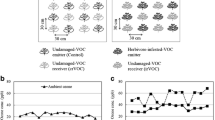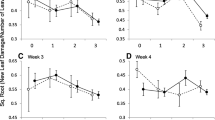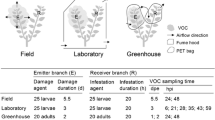Abstract
Plants release volatile organic compounds (VOCs) in response to wounding and herbivore attack, some of which trigger responses in neighboring unattacked plants in the laboratory under conditions that are not likely to occur in the real world. Whether plants ‘eavesdrop’ on the volatile emissions of their neighbors in nature is not known. The best documented field study of between-species signaling via above-ground VOCs involves increases in fitness parameters of native tobacco (Nicotiana attenuata) transplanted adjacent to clipped sagebrush (Artemesia tridentata tridentata). Clipped sagebrush releases many biologically active VOCs, including methyl jasmonate (MeJA), methacrolein and a series of terpenoid and green leaf VOCs, of which MeJA, while active under laboratory conditions, is not released in sufficient quantities to directly elicit induced resistance in the field. Here we demonstrate, with laboratory and field-based experiments, that priming (rather than direct elicitation) of native N. attenuata’s induced chemical defenses by a sagebrush-released VOC bouquet can account for earlier findings. With microarrays enriched in N. attenuata herbivore-regulated genes, we found transcriptional responses in tobacco growing adjacent to clipped sagebrush foliage, but failed to detect the direct elicitation of defensive chemicals or proteins. However, we observed an accelerated production of trypsin proteinase inhibitors when Manduca sexta caterpillars fed on plants previously exposed to clipped sagebrush. This readying of a defense response, termed priming, results in lower total herbivore damage to plants exposed to clipped sagebrush and in a higher mortality rate of young Manduca caterpillars. Our study demonstrates priming of plant defense responses as a mechanism of plant–plant signaling in nature, and provides an example for the analysis of between-plant signaling under ecologically realistic conditions. Although we describe priming as a potential mechanism for signaling between plants in nature, we critically discuss the ecological relevance of the particular interaction.







Similar content being viewed by others

References
Agrawal AA (2000) Communication between plants: this time it’s real. Trends Ecol Evol 15:446
Almeras E, Stolz S, Vollenweider S, Reymond P, Mene-Saffrane L, Farmer EE (2003) Reactive electrophile species activate defense gene expression in Arabidopsis. Plant J 34:202–216
Arimura G, Ozawa R, Horiuchi J, Nishioka T, Takabayashi J (2001) Plant–plant interactions mediated by volatiles emitted from plants infested by spider mites. Biochem System Ecol 29:1049–1061
Arimura G, Ozawa R, Shimoda T, Nishioka T, Boland W, Takabyashi J (2000a) Herbivory-induced volatiles elicit defence genes in lima bean leaves. Nature 406:512–515
Arimura G, Tashiro K, Kuhara S, Nishioka T, Ozawa R, Takabayashi J (2000b) Gene responses in bean leaves induced by herbivory and by herbivore-induced volatiles. Biochem Biophys Res Commun 277:305–310
Baldwin IT (1998) Jasmonate-induced responses are costly but benefit plants under attack in native populations. Proc Natl Acad Sci USA 95:8113–8118
Baldwin IT, Kessler A, Halitschke R (2002) Volatile signaling in plant–plant–herbivore interactions: what is real? Curr Opin Plant Biol 5:351–354
Bruin J, Sabelis MW, Dicke M (1995) Do plants tap SOS signals from their infested neighbors? Trends Ecol Evol 10:167–170
Charron CS, Cantliffe DJ, Wheeler RM, Manukian A, Heath RR (1996) Photosynthetic photon flux, photoperiod, and temperature effects on emissions of (Z)-3-hexenal, (Z)3-hexenol, and (Z)-3-hexenyl acetate from lettuce. J Am Soc Hort Sci 121:488–494
Croft KPC, Juttner F, Slusarenko AJ (1993) Volatile products of the lipoxygenase pathway evolved from Phaseolus vulgaris (L.) leaves inoculated with Pseudomonas syringae pv. phaseolicola. Plant Physiol 101:13–24
De Moraes CM, Schultz JC, Mescher MC, Tumlinsoni JH (2004) Induced plant signaling and its implications for environmental sensing. J Tox Environ Health 67:819–834
Dicke M, Bruin J (2001) Chemical information transfer between plants: back to the future. Biochem System Ecol 29:981–994
Dicke M, van Loon JJA (2000) Multitrophic effects of herbivore-induced plant volatiles in an evolutionary context. Entomol Exp Appl 97:237–249
Engelberth J, Alborn HT, Schmelz EA, Tumlinson JH (2004) Airborne signals prime plants against insect herbivore attack. Proc Natl Acad Sci USA 101:1781–1785
Farmer EE, Ryan CA (1990) Interplant communication—airborne methyl jasmonate induces synthesis of proteinase-inhibitors in plant leaves. Proc Natl Acad Sci USA 87:7713–7716
Glawe GA, Zavala JA, Kessler A, Van Dam NM, Baldwin IT (2003) Ecological costs and benefits correlated with trypsin protease inhibitor production in Nicotiana attenuata. Ecology 84:79–90
Halitschke R, Gase K, Hui DQ, Schmidt DD, Baldwin IT (2003) Molecular interactions between the specialist herbivore Manduca sexta (Lepidoptera, Sphingidae) and its natural host Nicotiana attenuata. VI. Microarray analysis reveals that most herbivore-specific transcriptional changes are mediated by fatty acid-amino acid conjugates. Plant Physiol 131:1894–1902
Halitschke R, Kessler A, Kahl J, Lorenz A, Baldwin IT (2000) Ecophysiological comparison of direct and indirect defenses in Nicotiana attenuata. Oecologia 124:408–417
Harley P, Deem G, Flint S, Caldwell M (1996) Effects of growth under elevated UV-B on photosynthesis and isoprene emission in Quercus gambelii and Mucuna pruriens. Global Change Biol 2:149–154
Heiden AC et al. (1999) Emission of volatile organic compounds from ozone-exposed plants. Ecol Applicat 9:1160–1167
Karban R (2001) Communication between sagebrush and wild tobacco in the field. Biochem System Ecol 29:995–1005
Karban R, Baldwin IT, Baxter KJ, Laue G, Felton GW (2000) Communication between plants: induced resistance in wild tobacco plants following clipping of neighboring sagebrush. Oecologia 125:66–71
Karban R, Baxter KJ (2001) Induced resistance in wild tobacco with clipped sagebrush neighbors: the role of herbivore behavior. J Insect Behav 14:147–156
Karban R, Maron J (2002) The fitness consequences of interspecific eavesdropping between plants. Ecology 83:1209–1213
Karban R, Maron J, Felton GW, Ervin G, Eichenseer H (2003) Herbivore damage to sagebrush induces resistance in wild tobacco: evidence for eavesdropping between plants. Oikos 100:325–332
Keinanen M, Oldham NJ, Baldwin IT (2001) Rapid HPLC screening fo jasmonate-induced increases in tobacco alkaloids, phenolics a diterpene glycosides in Nicotiana attenuata. J Agri Food Chem 49:3553–3558
Kessler A, Baldwin IT (2001) Defensive function of herbivore-induced plant volatile emission in nature. Science 291:2141–2144
Kessler A, Baldwin IT (2002) Manduca quinquemaculata’s optimization of intra-plant oviposition to predation, food quality and thermal constraints. Ecology 83:2346–2354
Kessler A, Baldwin IT (2004) Herbivore-induced plant vaccination. Part I. The orchestration of plant defenses in nature and their fitness consequences in the wild tobacco Nicotiana attenuata. Plant J 38:639–649
Krügel T, Lim M, Gase K, Halitschke R, Baldwin IT (2002) Agrobacterium-mediated transformation of Nicotiana attenuata, a model ecological expression system. Chemoecology 12:177–183
Lerdau M, Gray D (2003) Ecology and evolution of light-dependent and light-independent phytogenic volatile organic carbon. New Phytol 157:199–211
Lerdau M, Slobodkin K (2002) Trace gas emissions and species-dependent ecosystem services. Trends Ecol Evol 17:309–312
Personius TL, Wambolt CL, Stephens JR, Kelsey RG (1987) Crude terpenoid influence on mule deer preference for sagebrush. J Range Managem 40:84–88
Preston CA, Laue G, Baldwin IT (2001) Methyl jasmonate is blowing in the wind, but can it act as a plant–plant airborne signal? Biochem System Ecol 29:1007–1023
Preston CA, Laue G, Baldwin IT (2004) Plant–plant signaling: application of trans- or cis-methyl jasmonate equivalent to sagebrush releases does not elicit direct defenses in native tobacco. J Chem Ecol 30:2193–2214
Schmelz EA, Alborn HT, Engelberth J, Tumlinson JH (2003) Nitrogen deficiency increases volicitin-induced volatile emission, jasmonic acid accumulation, and ethylene sensitivity in maize. Plant Physiol 133:295–306
Shonle I, Bergelson J (1995) Interplant communication revisited. Ecology 76:2660–2663
Tscharntke T, Thiessen S, Dolch R, Boland W (2001) Herbivory, induced resistance, and interplant signal transfer in Alnus glutinosa. Biochem System Ecol 29:1025–1047
van Dam NM, Horn M, Mares M, Baldwin IT (2001) Ontogeny constrains the systemic proteinase inhibitor response in Nicotiana attenuata. J Chem Ecol 27:547–568
Voelckel C, Baldwin IT (2004) Herbivore-induced plant vaccination. Part II. Array-studies reveal the transience of herbivore-specific transcriptional imprints and a distinct imprint from stress combinations. Plant J 38:650–663
Weber H, Chetelat A, Reymond P, Farmer EE (2004) Selective and powerful stress gene expression in Arabidopsis in response to malondialdehyde. Plant J 37:877–888
Zavala JA, Patankar AG, Gase K, Baldwin IT (2004a) Constitutive and inducible trypsin proteinase inhibitor production incurs large fitness costs in Nicotiana attenuata. Proc Natl Acad Sci USA 101:1607–1612
Zavala JA, Patankar AG, Gase K, Hui DQ, Baldwin IT (2004b) Manipulation of endogenous trypsin proteinase inhibitor production in Nicotiana attenuata demonstrates their function as antiherbivore defenses. Plant Physiol 134:1181–1190
Zepp RG, Callaghan TV, Erickson DJ (1998) Effects of enhanced solar ultraviolet radiation on biogeochemical cycles. J Photochem Photobiol B 46:69–82
Acknowledgements
This research was supported by the Max-Planck-Gesellschaft. We thank Michael Haevecker and Robert Schlögl from the Fritz-Haber-Institut of the Max-Planck-Gesellschaft for the generous use of their PTR-MS and patient instructions for its use and the Brigham Young University for the use of their awesome field station, the Lytle Preserve.
Author information
Authors and Affiliations
Corresponding author
Additional information
Communicated by Judith Bronstein
Electronic supplementary material
Rights and permissions
About this article
Cite this article
Kessler, A., Halitschke, R., Diezel, C. et al. Priming of plant defense responses in nature by airborne signaling between Artemisia tridentata and Nicotiana attenuata . Oecologia 148, 280–292 (2006). https://doi.org/10.1007/s00442-006-0365-8
Received:
Accepted:
Published:
Issue Date:
DOI: https://doi.org/10.1007/s00442-006-0365-8



